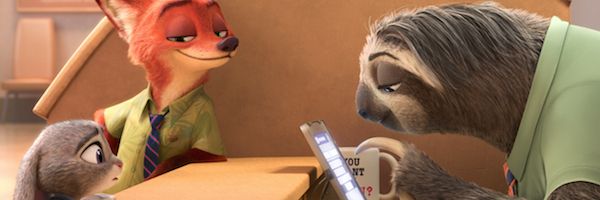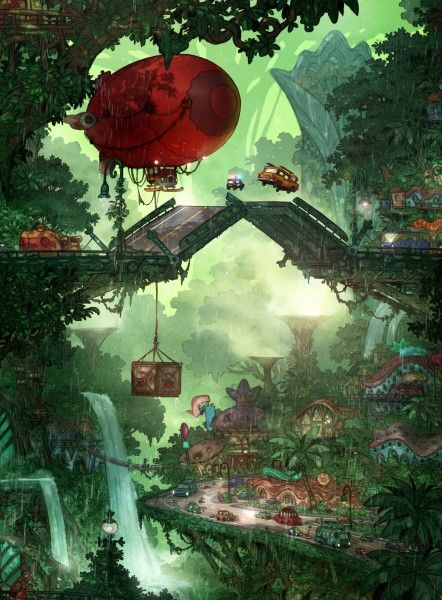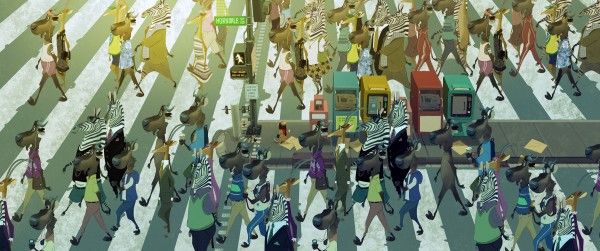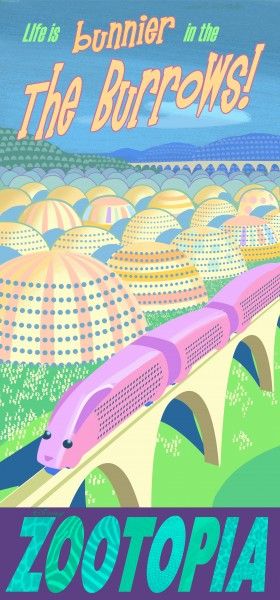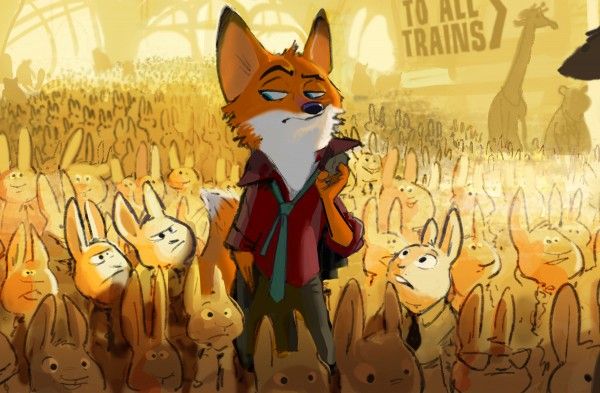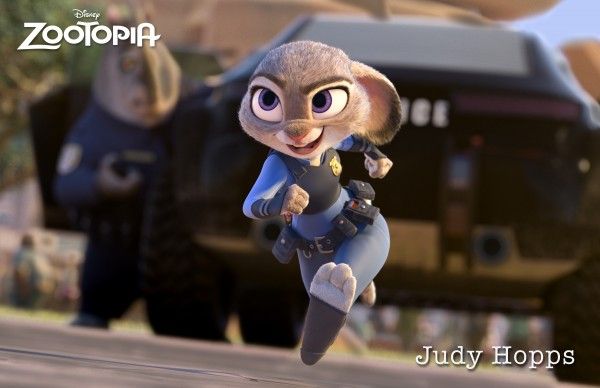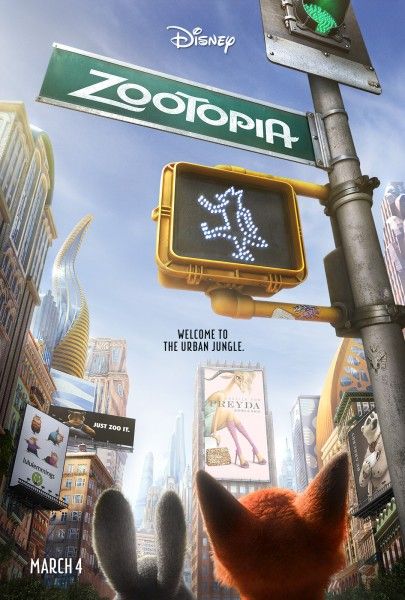Zootopia is a modern, civilized world that’s entirely animal. It’s a city like no other, comprised of habitat neighborhoods that are a melting pot where animals from every environment live together and where, no matter what you are, from the biggest elephant to the smallest shrew, you can be anything. But, when optimistic Officer Judy Hopps (voiced by Ginnifer Goodwin) arrives, she discovers that being the first bunny on a police force of big, tough animals isn’t so easy. She’s determined to prove herself and crack a case, but she’ll have to partner with a fast-talking, scam-artist fox, named Nick Wilde (voiced by Jason Bateman), to do so.
In October, Collider (along with various other entertainment outlets) was invited to check out some scenes from the March 4th release and attend a handful of presentations at the Disney Animation Tujunga campus, where we learned about character creation, the blending of animal and human behavior, production design and the extensive research they did to bring it all to life. Throughout the day, it became quite clear that there is attention paid to every single detail, no matter how small, the environments in the film are beautiful to look at, and that the humor and heart that audiences have come to expect from Disney Animation features will be present.
Here are 20 things we learned about Zootopia, from the early press day for the film:
-
It’s the studio’s goal, each and every day, to make contemporary and ground-breaking films that inspire and tell great stories. Through the story trust, which is a mix of directors, writers and story artists, they challenge each other to push their films to a new level of excellence. They strive to tell timeless stories that appeal to audiences, they want the movies to be entertaining for all ages, the films must contain a combination of great humor and deep emotion, and the films must represent the style of Walt Disney because his name is on them.
- When they started thinking about the story they wanted to tell next, they kept coming back to wanting to tell a story of animated animals in a city called Zootopia. Once they decided what the film would be, the filmmakers spent 18 months just studying animals. They started at Animal Kingdom at Walt Disney World and Wild Animal Park in San Diego, and then they went to Kenya for two weeks to study animals in the wild, in order to capture what makes them so amazing in the natural world.
- They researched fur at the microscopic level, in order to get the look of the animals accurate, even going to the Natural History Museum in Los Angeles to get super close to actual fur of different species. Every animal in Zootopia has completely different fur based on the actual strands of fur for that animal. The filmmakers wanted the world of Zootopia to feel alive with the vegetation that’s placed in it. The wind doesn’t just affect the trees, but the characters themselves and their fur, since almost all of them have fur.
-
The animators had to take animals that naturally walk on all fours and put them on two legs, in a realistic way. They studied the animals actual movements to translate that into how they would walk on two legs and how they would even dance. And instead of making the different animals’ heights be close to each other, they wanted to make sure the height of each animal would be to scale, compared to the other animals. Zootopia had to be built to accommodate every animal.
- Zootopia has different neighborhoods to celebrate different climates, and just like our own world, the animals of Zootopia are quick to put each other in a box of stereotypes. For the desert animals, there’s Sahara Square, a huge desert area that’s hot and dry. It’s like an upscale Dubai or Monte Carlo with high-end shops, and they took a research trip to Vegas when they were designing it. There is chilly Tundratown where the cold weather animals live, where there is coolant underneath the sidewalks to keep it cold and they have a 3 o’clock blizzard. And then, there’s the Rainforest District where it’s wet and humid. There is also a town with a little, bitty neighborhood called Little Rodentia, which is like Greenwich Village, but two feet high, and it’s where all of the mice live. Bunny Burrows has millions of bunnies living there, with a population that’s always multiplying. You can essentially go on an international tour in one metropolis.
- The world of Zootopia is so huge that there are cities that had to get cut out of the film, but they exist on the map. The Meadowlands is all sheep. Outback Island is an Australian district. There is a nocturnal district with a city of caves. And there are probably other cities with reptiles and birds.
-
When it came to actually populating Zootopia, they had to think about the animals that would fit into the different cities. On top of that, they had to provide a variety of clothing for each character. For every species, they had to create the male and female adults, and male and female children, and provide some variety so that you didn’t just see the same animal, over and over. They also wanted to make sure to keep their animal characteristics and not make them too human. There are about 400 unique species and costume set-ups in Zootopia, with over 800,000 unique potential characters in total.
- Before they start drawing the characters, the designers talk to the directors and writers to find out what they’re hoping to get out of the characters and what they’re going to need to do. They want to make sure that each character’s really strong personality can shine through their design.
- The first design choice they made was to plant the animals’ feet flat on the ground. It’s a combination of human anatomy and animal anatomy, and it allows clothes to fit on animals like they do on people. There are a lot of body types and a lot of different clothing fits in Zootopia.
- The characters in Zootopia are never just standing around. There’s always a little story or a little something going on, which you often don’t even notice until a second viewing.
- We’re introduced into the world of Zootopia through the eyes of the lead character, Judy Hopps, voiced by Ginnifer Goodwin. Judy is a young female bunny from Bunny Burrows, who moves to the big city to follow her dreams of becoming the first bunny cop with the Zootopia Police Dept. It’s a really big deal because the cops are all large animals, like buffalo, rhinos and hippos, but Judy is determined to be a cop. Her manta is “Anyone can be anything,” and she believes it to her core, but she is hit with harsh realities that try to keep her from following her dream.
-
On her journey, Judy meets a sneaky fox, named Nick Wilde, who’s voiced by Jason Bateman. Unlike Judy, who believes that anyone can do anything, Nick believes that we are who we are, stereotypes and all, and we will never escape that.
- Through a series of circumstances, Judy ends up on the case of a missing otter, which she has to solve or she’ll be kicked off the police force. The only witness in the case turns out to be Nick, who was the last one to see the missing otter, forcing them to have to work together. Judy is determined to prove that she can be a real cop, even though Nick enjoys making things very difficult for her. But, the case turns out to be a part of something much more complex than either of them thought or expected.
- For this story, the filmmakers wanted the lead characters to be natural enemies that have to work together and rely on each other. They wanted the two animals to both be relatively small and feel like underdogs.
- The filmmakers had a very short list for the actors they were interested in, to voice both Judy Hopps and Nick Wilde. For Nick, they needed someone charming and smart, but not off-putting, and that led them to Bateman. Both Goodwin and Bateman have been with the project for two years.
- The actors are filmed while they’re in the recording studio, recording their lines, and then the animators watch the videos to see if there are gestures that they can add to the performances.
-
With all of the designs for the film, as the story changes, the characters have to change. When they’re asked to do something different in the story, the design has to account for that. Early on, Judy was just cute, but then they realized she was so much more than that and needed to have her broad personality reflect that. She started off feeling a little more young and vulnerable, but they wanted her to be a stronger, more active woman who was driving the action. She also had to have a physicality that made her believable as a legitimate police officer. And early versions of Nick had him as more of a sick con man, but then the story changed and he had to be capable of so much more, including a broader range of emotion and a more human personality.
- The character of Bogo, the police chief, needed to be intimidating whenever he was on the screen. To get the feel right, they looked at body builders who are also in the Sheriff’s department or are police officers. They realized that none of them could button their top button, so they went with that style for Bogo.
- Shakira got involved with the film when the directors met her about two years ago, and she fell in love with the idea and the central message. She performs an original song that’s heard in the film, and she voices the character of Gazelle. Gazelle is very popular in the world of Zootopia, and Judy is a big fan. She’s so important to the other animals because she’s very socially-minded and is all about acceptance and equality for all.
- The filmmakers see the message of the film as “you define you.” This film examines that theme and puts it to the test with the characters.
Zootopia opens in theaters on March 4, 2016.

